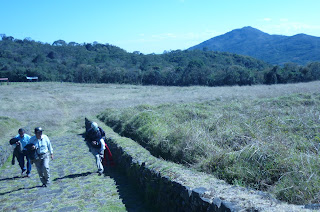Aypate looks for Budget to become worthy
AYABACA, Peru – What are the conditions that
the Aypate [pronounce Iappahteh] Archaeological Complex offers to receive the
tourism? None at the moment because the Inca-origin building is not officially
open for the tourism yet, although it does receive visitors who are allowed to
enter for free under strict conditions like to keep clean the whole circled
area, not to vandalize the building, and not to put on the walls, as it
happened before.
At
the moment, Peru’s Ministry of Culture and Lagunas de Canly Community are doing
maintenance works like weeding, but it still remains to continue the restoration
of monolithic walls those could be built after 1470 AD, when the armny commanded
by emperor Túpac Inca Yupanqui devastated the settlement of Ayawaka tribe as he
expanded the Tawantinsooyo Empire toward the north, what are the highlands of
actual Ecuador.
It is
supposed that Aypate was for the Ayawakas as their main administrative,
religious, and military center, but more information is not available because
the research has been making slowly since it was found in 1971 by the Italian anthropologist
Mario Polia and the local guide Celso Acuña, funded by the University of Piura.
Then up to today, the only relatively safe data are the brought by the
chronicles of the first Spanish conquerors, who entered the actual Peru in 1532
AD.
Although
the Ministry of Culture is already intervening about 100 hectares or 250 acres,
including the citadel built by the Incas and part of the Royal Trail or Cápac Ñan, that came from Cusco or Qosq’o, the imperial capital city. It still
remains many rrestoration Workss like rehabilitating walls deteriorated by the
time, which must be numbered, undone, and done again to avoid they fall down in
the long term.
FACTORTIERRA.NET
learned that the people in charge of the Aypate’s restoration project already
sent a budget request to Lima-based Ministry of Culture beginning 2019, but it
was not assisted until the deadline of this post yet. Employees in Aypate
assured that once the restoration Works end, the place could become worthy at
least, that would include signs and specialized services to the tourism. However,
part of the access path to the citadel already has three little sheds working as
resting points for the actual visitors. Also, trash cans were placed just
before the main gate.
Despite,
Aypate is considered as one of the wonders of Piura Region due to its
architecture, its location where you can look at almost all nascents of Quiroz River,
a tributary of Chira River, and the surrounding clody forest where native
species highlight as lanches, achoopayas, ferns, and even orchids. As it is
part of the Cápac-Ñan, it is included into the list of Humankind Patrimony
managed by UNESCO, and its more enthusiastic advocates rrank it as the Machupichu
of Peruvian Northern.
To
get to Aypate, you can start in the cities of Piura or Sullana, and climb up to
Ayabaca City, more than 200 km or 150 miles distance (about 5 hours by car),
and 2716 meters or 8911 feet altitude. Right there, you can take vehicles
those, after 90 minutes, arrive to its watch post where you have to register,
then walking uphill for about 20 to 30 minutes. The visit to the citadel can
last 30 minutes to one hour, depending on the interest and curiosity of the
visitor.
Aypate
is about 2500 meters or 8200 feet altitude. . It is a mostly tempered weather
along the most of year, 15°C or 59°F in average, although the best time of the
year to visit it runs from May to November, when it doesn’t rain. It is recommended
to go with a guide. If you need to hire one, or further information about the site,
write at factortierra@gmail.com or
through our Facebook or Twitter accounts.






Comentarios
Publicar un comentario